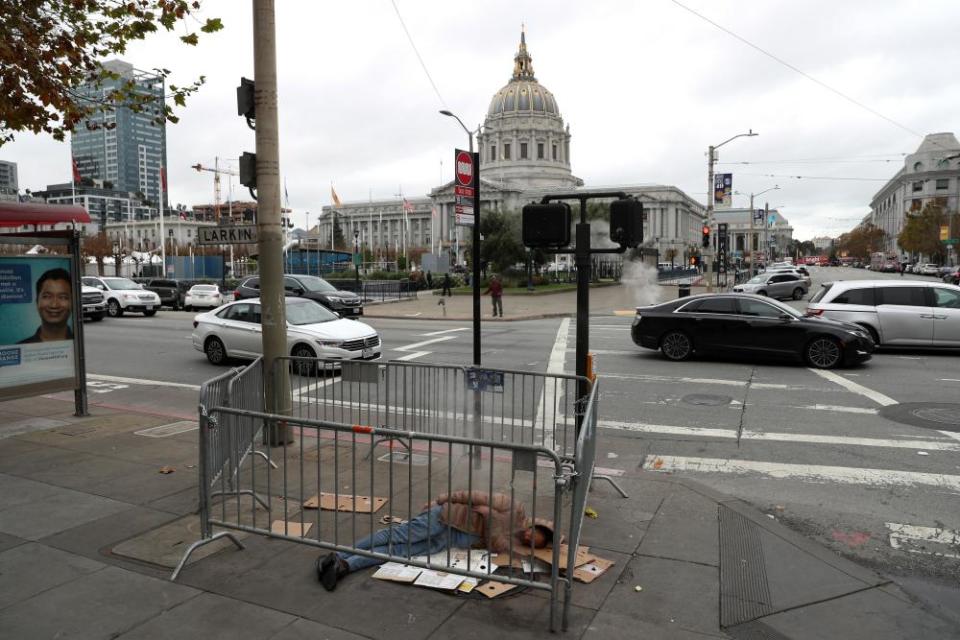San Francisco’s homeless deaths have tripled. Advocates blame shelter in place

San Francisco has seen a surge in deaths among homeless people this spring, fatalities that officials are not directly attributing to coronavirus but which advocates say is a result of the shelter-in-place order that forced people onto the streets.
From 30 March to 24 May, 48 people experiencing homelessness died in San Francisco, more than three times the 14 deaths recorded during this same period last year. Though some of those 48 tested positive “near their time of death,” their causes of death are still under investigation and have not been counted among the city’s Covid-related fatalities, according to the San Francisco department of public health.
There have been 40 Covid-related deaths officially recorded in San Francisco since the first case was reported in the city on 5 March.
Related: 'It's barely a Band-Aid': life inside San Francisco's first sanctioned tent camp
When Mayor London Breed joined the other Bay Area counties in putting into effect the nation’s first regional shelter-in-place order on 17 March, businesses and many places that provided services to homeless individuals had to close. Shelters, no longer taking in new guests during the pandemic, were forced to reduce capacity by 76% to adhere by social distancing guidelines.
In a statement, the city’s department of public health acknowledged that “measures San Franciscans have taken to protect our community from the virus and reduce its spread have been necessarily disruptive, and have saved lives, but they could also be having indirect impacts on other aspects of life for people experiencing homelessness”.
The coronavirus pandemic pushed the homelessness crisis that has always existed in San Francisco to a level unseen in recent history, with unhoused individuals left with no other option than to live on the streets. The number of tents increased throughout the city by 71% – in the historically underserved, low-income neighborhood of the Tenderloin, the number exploded by 258%.

Most of the 48 deaths occurred outdoors, and more in the Tenderloin than any other part of the city, according to the department of public health.
“These excess deaths I see as Covid deaths, whether or not they were from the virus or from the complete failure of the Covid response from the city,” said Dr Rupa Marya, an associate professor at the University of California, San Francisco, and co-founder of the Do No Harm Coalition. “They were deaths that would not have happened otherwise.”
Though the causes of death have not been released, the health department warned that “overdose deaths, especially those linked to fentanyl, have been increasing significantly over the last year”. Service providers and homeless outreach advocates fear that writing off these deaths as overdoses will allow the public to ignore them without understanding the context in which many in the homeless population turn to drugs.
Some on the streets are forced to stay up all night rather than risk falling asleep and getting assaulted or robbed, and end up addicted to drugs as a way to keep awake. Others suffer from underlying medical conditions and mental health issues that are not properly addressed, and find themselves managing their trauma with substances.
“There’s this mass misunderstanding that people are homeless because of their drug use but a lot of times their drug use is accelerated because of their homelessness,” said Mary Howe, the executive director of Homeless Youth Alliance. “It’s a way for them to cope with their homelessness.”
At the end of April, Howe got the text message that every homeless service provider dreads: the one informing her that someone she worked with and tried to get help for had died.
Ian Carrier was just 36. Howe had known him for 15 years, meeting first through her work with the Homeless Youth Alliance and remaining friends long after he stopped being considered a youth. He suffered from a slew of medical issues on top of addiction, and required regular dialysis. “We were trying to find somewhere for him to go, but no treatment center could legally take someone who was so medically unstable,” Howe said.
He had been hospitalized for three out of the four months before his death. The day before he was found dead, Carrier had called Howe, who had been appointed to make medical decisions for him if he could not, informing her that the hospital was planning to discharge him and he needed clothing. Howe could tell that he was still unwell, unable to hold a conversation, and tried to secure him one of the hotel rooms that the city had said they would provide for homeless individuals who had tested positive, were medically vulnerable or were more than 60 years old. She was unable to get one.
Just hours after being discharged from the hospital, Carrier died in his wheelchair at a makeshift encampment in the shadow of City Hall. A week later, the city put up fences and turned that site into a city-sanctioned encampment.

